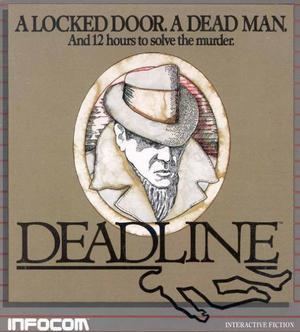8.8 /10 1 Votes
Engine ZIL Initial release date 1982 Developer Infocom | 4.4/5 My Abandonware Mode(s) Single-player Genre Interactive fiction Designer Marc Blank | |||||||||||||||||||||||||||||||||
 | ||||||||||||||||||||||||||||||||||
Release date(s) Release 18: March 11, 1982
Release 19: April 27, 1982
Release 21: May 12, 1982
Release 22: August 9, 1982
Release 26: November 8, 1982
Release 27: October 5, 1983 Platforms Commodore 64, DOS, Apple II Publishers Infocom, Commodore International Similar Infocom games, Interactive fiction games | ||||||||||||||||||||||||||||||||||
Deadline is an interactive fiction computer game published by Infocom in 1982. Written by Marc Blank, it was one of the first murder mystery interactive fiction games. Like most Infocom titles, Deadline was created using ZIL. It is Infocom's third game.
Contents
Plot
The player's character in Deadline is an unnamed police detective, summoned to a sprawling Connecticut estate to investigate the apparent suicide of wealthy industrialist Marshall Robner. At first, it seems a very straightforward case: the body was discovered in the library, which had been locked from the inside, and the cause of death was an overdose of his prescribed antidepressants. But something just doesn't feel right. Could someone have killed Robner for his money? Did he make an enemy through his business dealings? Or was there some other motive? With the able assistance of level-headed Sgt. Duffy, the player has twelve hours to solve the case before it is closed forever.
The suspects, who walk around the estate pursuing their own agendas during your investigation, are:
New commands were implemented to suit the game's detective theme: the player can accuse or even arrest any of the suspects at any time. A well-timed accusation can cause an unnerved suspect to reveal previously concealed information. For an arrest to stick, however, the player must possess hard evidence of the three basics: motive, method and opportunity. Without these, the game ends with a description of why the presumed culprit was released. The standard examine and search commands are present, of course, but the player can also fingerprint objects or ask the invaluable Sgt. Duffy to analyze them.
Development
While writing Deadline, Marc Blank was strongly inspired by the 1930s out-of-print books written by Denis Wheatley. The working title of the game was "Who Killed Marshall Robner", a reference to Wheatley's Who Killed Robert Prentiss. Blank wanted the player to feel like a detective while playing the game, and designed the game and its feelies around that. Because Deadline displayed a timer rather than the movecount and score that other Infocom games of its time showed, the game needed a custom interpreter, which made porting the game to different computers more difficult.
Feelies
When writing this game, Blank couldn't include all of the game's text in the limited 80KB of disk space. Working with a newly hired advertising agency, Infocom created the first feelies for this game: extra items that gave more information than could be included within the digital game itself. These materials were of very high quality and their inclusion with a computer game was unprecedented. Critics and fans hailed Infocom's pioneering move and gushed over the feelies' high quality and the immersiveness they added to the game. The feelies included:
(Note that in later "grey-box" editions of Deadline, many of these documents were incorporated into the Casebook, rather than existing as separate papers.)
These materials were very difficult for end-users to copy or otherwise reproduce. They included information which was essential to completing the game. So, as a side effect, the feelies acted as a deterrent to software piracy. Infocom thus started including feelies in their subsequent releases, though not every game required the use of the included feelies.
Reception
Although Computer Gaming World's reviewer disliked the solution to Deadline's mystery, she praised the game's realism, documentation, extensive command vocabulary, and the frustration involved in both finding the killer and presenting enough evidence for a conviction. BYTE called Deadline "fascinating" and "great fun", calling the multiple endings "a radical departure from the prototypical mystery". PC Magazine called it "of the highest quality. It is thoroughly researched and tested, and it is virtually flawless". The game received an award for "Best Computer Adventure" at the 4th annual Arkie Awards, where judges attributed the "richness and realism" of the game's dialogue to the advanced text parser that allows natural language input rather than the "telegraphic verb-noun phrases that other such disks generally employ". The New York Times Book Review also mentioned the narrative and participatory character of the game a few months later. K-Power rated Deadline 8 points out of 10, stating that the game "is very exciting, is as good, or better, than Zork, and will bring long hours of enjoyment and, best of all, intrigue".
